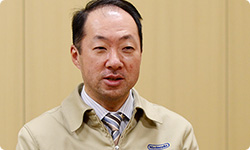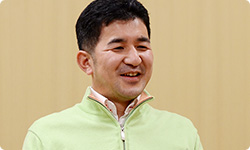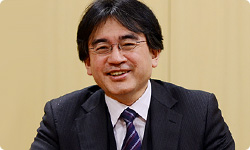1. The Ever-Changing Music of Hyrule Field
Thank you for coming today.
It’s our pleasure.
This year is the twenty-fifth anniversary of The Legend of Zelda1. Today, I would like to ask you about the music in The Legend of Zelda. You have both appeared in “Iwata Asks” before, but would you please introduce yourselves? 1The twenty-fifth anniversary of The Legend of Zelda: The first game in the series was released for the Family Computer Disk System in Japan in February 1986. The year 2011 marks 25 years since then.
I’m Kondo from the Sound Group in the Software Development Department of the Entertainment Analysis & Development Division (EAD).

In Super Mario Bros. 25th Anniversary, you said that the second game you worked on was Super Mario Bros2. Does that mean your third game was The Legend of Zelda3, for which you worked on the music? 2Super Mario Bros.: An action game released for the Family Computer (Famicom) system in Japan in September 1985. 3The Legend of Zelda: An action-adventure game released simultaneously with the Family Computer Disk System in Japan in February 1986.
Yes, that’s right.
It’s amazing that a new employee at Nintendo would make the music for Super Mario Bros. as the second game he worked on, and then for his third game, make the music for The Legend of Zelda.
I remember the development periods were right next to each other, with only about three months in between.
Nintendo practically made Super Mario Bros. and The Legend of Zelda at the same time.
Yes.
The Legend of Zelda was for the Family Computer Disk System, which came out after the Famicom system, so you could use a new sound source.
Yes. We could only use three sounds with the Famicom system, so that was hard.
It went from three to four, and with the new sound source it was possible to output sounds that were completely different than before.
Yes. We mostly used the new sound source for sound effects, but just having one more was a big help, so I had a good time as I worked.
Alright, and Yokota-san?
Yes?
Compared to Kondo-san, you may not have worked on development of The Legend of Zelda games that long, but you’ve been playing it forever, right?
You can say that again!
Oh? (laughs)
Talking about it could take forever! (laughs) I love The Legend of Zelda: Ocarina of Time4 beyond all reason! 4The Legend of Zelda: Ocarina of Time: An action-adventure game first released for the Nintendo 64 system in Japan in November 1998. It was the first game in the Legend of Zelda series to feature 3D graphics.

Go on, tell me about it! (laughs)
What about my self-introduction?
Oh, I forgot! (laughs) By all means, introduce yourself!
I’m Yokota from the EAD Tokyo Software Development Department. I appeared in Iwata Asks - Super Mario Galaxy 2, but some people may wonder why I’m here talking about The Legend of Zelda.
I suppose so.
I’ve been totally immersed in The Legend of Zelda this past year.
Immersed in Zelda?
I’ve only been working on The Legend of Zelda series. Two games at the same time!
Huh? Two at the same time? I didn’t know that!
One is The Legend of Zelda: Ocarina of Time 3D and the other is The Legend of Zelda: Skyward Sword5. 5The Legend of Zelda: Skyward Sword: The newest title in the series. Scheduled for release in 2011 for the Wii console.
After development of Super Mario Galaxy 26 ended? 6Super Mario Galaxy 2: A 3D action game released for the Wii console in Japan in May 2010.
Yes. That’s about the time. At E37 last year, when we were going to exhibit Skyward Sword for the first time, we talked about using orchestral music. But (Shigeru) Miyamoto-san said it wasn’t necessary. 7E3 (Electronic Entertainment Expo): A video game trade show usually held once a year in Los Angeles.
We were going to have attendees of last year’s E3 try out the new game’s operability, so he said orchestral music wasn’t necessary right away.
Right. Then, toward the end of summer break, they finally decided to put in orchestral music and I joined the development team.
You’re sort of the orchestration director for the Legend of Zelda music, aren’t you?
Yes. I was in charge of the orchestral songs for The Legend of Zelda: Twilight Princess8 as well. 8The Legend of Zelda: Twilight Princess: An action-adventure game released for the Wii console and the Nintendo GameCube system in December 2006.
Now pour out your love for Ocarina of Time! (laughs)
Okay! (laughs) I have, of course, played all the Zelda games since the first one, and played them all the way through, but Ocarina of Time was an eye-opening experience as to how great video game music can be. I played song after song on the piano.
I feel like I heard something similar when we talked about Iwata Asks - Super Mario All-Stars9. (laughs) 9Super Mario All-Stars Limited Edition: Released for the Wii console to celebrate the twenty-fifth anniversary of Super Mario Bros. It included Super Mario Bros. and three other games. It is no longer available.
Really? I talked about that? (laughs) When Ocarina of Time came out, I was working at a different company, and I went around haranguing everyone about how amazing the sound was.
I feel like I’ve heard that, too. I’ve got déjà vu! (laughs)
Oh, sorry! I’m like a repeating record! (laughs) I may have said the same thing about Super Mario Sunshine10. 10Super Mario Sunshine: A 3D action game released for the Nintendo GameCube system in Japan in July 2002.
(laughs)
Getting back to Ocarina of Time, the music was different every time you went out to a dungeon on an adventure and came back to Hyrule Field, the main setting of the game. The general feeling of the music itself didn’t change that much, but the melodies came along at a different tempo. And even if it was the same song, if you were fighting an enemy, the tune would become more thrilling. Then, when the battle was over, it would return to the usual majestic music . When Link stood still, it would grow quiet . The music was constantly changing.
It didn’t always play the exact same music.
Right. In the land of Hyrule, the music changed between three patterns, normal, battle and quiet.
Back then when there were still strict restrictions in the amount of memory that you could allocate to sound, it was common to stream pre-created music tracks. But by taking advantage of the ROM cartridge of the Nintendo 64 system, it was possible for the music tracks to be combined and generated depending on the situation. That is why in Ocarina of Time, music was constantly changing throughout the entire game. But even though Kondo-san did that for the sound on Hyrule Field, I doubt many people back then noticed and could talk about it.

Not many people noticed.
Yeah, I bet not. So, aren’t you a little happy that Yokota-san did? (laughs)
(looking really happy) I’m so happy! (laughs)
(laughs)
He noticed! He really noticed!!
Is it like, “Please say that again!”?
Yes, I’m ultra-happy that he noticed it! (laughs)